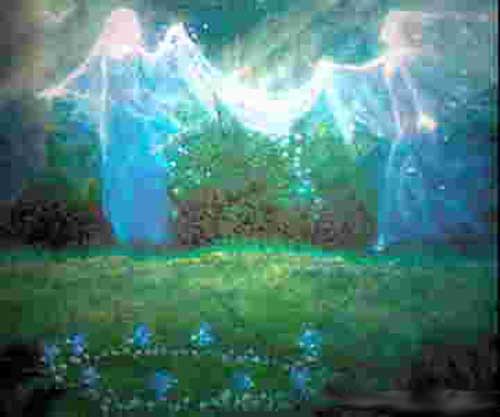

Sylph (also called sylphid) is a mythological creature in the Western tradition. The term originates in Paracelsus, who describes sylphs as invisible beings of the air, his elementals of air. There is no known substantial mythos associated with them. Sometimes they are depicted as cloud beings. Sylphs are responsible for the myths of angels, the winged protectors of the Garden of Eden. Their attitudes embody the extremes of nature, mercurial and intense. Most of all, they defend the high peaks and wilderness mountains that are their home.

As creatures of the air the great wings of the Sylph allow them to soar with the eagles. Sylphs are believed to be an offshoot branch of the sidhe, a supernatural race comparable to the fairies or elves, also winged rulers of the dream world, controllers of the weather and the great birds of the mountains both regal in manner.
Theirs is an ancient and proud legacy that some believe is dying out. Most sylphs feel that this is the end of their race, that they will be the first of the kiths to slip into the Fimbulwinter. It is for this reason that they have come down from their mountains and rejoined changeling society in large numbers. If they are to cease to exist, then at least they will be remembered for the honor, glory and majesty that is inherent to their kind. Sylphs care little for the machinations and politics of "ground folk", and they rarely interfere with changeling society. Like trolls, sylphs hold their word of honor to be inviolate, and once sworn to protect something, they will defend it to (or even past) their death.

Sylphs resemble tall, lithe humans - with one exception. Sprouting from their backs are a pair of huge feathered wings. These wings are almost 2 body-lengths long, but fold up behind the sylph when they are on the ground. Their eyes are large and shaped like a hawk's, and their faces are sharp and angular.
Childlings sylphs are timid and flighty. They rarely associate with others, but when they do, they usually form bonds that last for life. They are called Cherubs by the rest of changeling society.
Wilder sylphs are intense and direct, like the birds of prey they resemble. They soar endlessly through the skies, looking for something to attract their interests and allow them to prove their worth.
As alchemy in the West derived from Paracelsus, alchemists and related movements, such as Rosicrucianism, continued to speak of sylphs in their hermetic literature.
The first mainstream western discussion of sylphs comes with Alexander Pope. In Rape of the Lock, Pope satirizes French Rosicrucian and alchemical writings when he invents a theory to explain the sylph. In a parody of heroic poetry and the "dark" and "mysterious" literature of pseudo-science, and in particular the sometimes esoterically Classical heroic poetry of the 18th century in England and France, Pope pretends to have a new alchemy, in which the sylph is the mystically, chemically condensed humors of peevish women.
In Pope's poem, women who are full of spleen and vanity turn into sylphs when they die because their spirits are too full of dark vapors to ascend to the skies. Belinda, the heroine of Pope's poem, is attended by a small army of sylphs, who foster her vanity and guard her beauty.
This is a parody of Paracelsus, inasmuch as Pope imitates the pseudo-science of alchemy to explain the seriousness with which vain women approach the dressing room. In a slight parody of the divine battle in Alexander Pope's Rape of the Lock, when the Baron of the poem attempts to cut a lock of Belinda's hair, the sylphs interpose their airy bodies between the blades of the scissors (to no effect whatsoever). The chief sylph in The Rape of the Lock has the same name as Prospero's servant in Shakespeare's The Tempest: Ariel.
Willow, in Terry Brooks' Magic Kingdom of Landover series is a sylph and the wife of protagonist Ben Holiday. She is the daughter of the River Master and a wood elemental, giving her pale green skin and emerald hair. Her dual nature is reflected in the fact that she must transform into a Willow tree once every 21 days to maintain her life force. She has a tense and distant relationship with her father, as her existence serves as a permanent reminder to him of the brief relationship that he desires to reclaim, but never can. And so it is to her mother that she turns for guidance.

Because of their association with the ballet La Sylphide, where sylphs are identified with fairies and the medieval legends of fairyland, as well as a confusion with other "airy spirits" (e.g., in William Shakespeare's A Midsummer Night's Dream), a slender girl may be referred to as a sylph.
Sylph has passed into general language as a term for minor spirits, elementals, or faeries of the air. Fantasy authors will sometimes employ sylphs in their fiction. Sylphs could create giant artistic clouds in the skies with their airy wings.

Cloud Angels